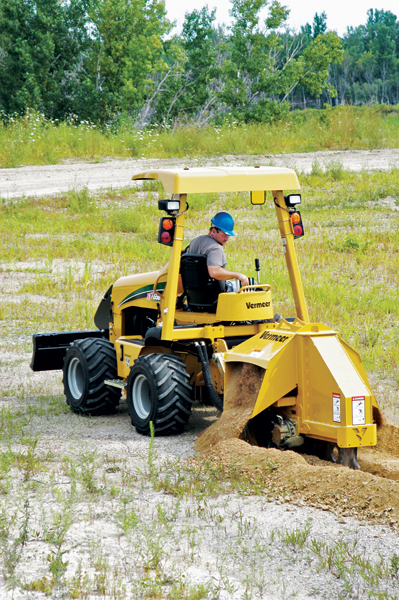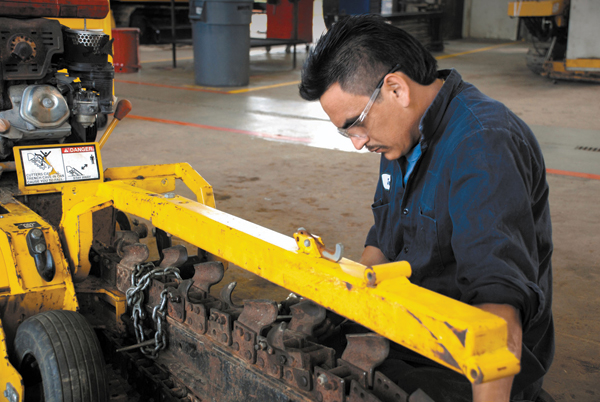Dig Long and Prosper
What we typically describe as utility trenchers —ride-on trenchers having anywhere from 40 to 70 hp (29.3 to 52.2 kW) — are far more versatile in their capability than just digging trenches. A ride-on utility trencher is a tractor with a trencher attachment. Utility tractors within this horsepower range are used in a multitude of applications, such as laying fiber-optic cable, water line installation and landscaping irrigation.
Maintenance for Maximum Efficiency
Whether a tractor has a trencher or another attachment, the tractor itself is the biggest investment, and proper operation and maintenance will provide multiple benefits. Being proactive with your maintenance will keep the tractor working efficiently. The key to maximum productivity for any piece of utility equipment is regular maintenance, and it’s the easiest to accomplish in minimal time, as long as you follow manufacturer maintenance recommendations and stick to the schedule. A common mistake that causes machine failures or inefficient operation is not following maintenance procedures.
According to Rocky Hizer, utility service manager for Vermeer Corp., the first thing a contractor needs to do upon delivery of a new machine is to put the reference technical materials supplied with the machine in a safe place where they are readily accessible.
“Maintenance procedures are grouped into daily, weekly, monthly, semiannual and annual, which are associated with machine hours,” says Hizer. “Equipment manufacturers detail in their manuals what items need to be done and how often.”
Typical daily maintenance includes a full visual inspection of the machine, looking for any damage and greasing the end idler, bearings and cylinder ends. Other daily items may include: fill your fuel tank; check all fluid levels; check the air cleaner restriction indicator; and drain your fuel/water separator if applicable. Hizer recommends this work be performed at the end of the shift. Hizer says most of this should take a competent technician about 15 minutes. Of course, this may vary depending on recommendations by each manufacturer.
“No one needs to dig in there and turn wrenches necessarily. Daily maintenance is typically a full grease job and an overall inspection of the machine,” says Hizer. “Most of these items involve looking at the machine and making sure everything is OK.”
Weekly maintenance may involve looking at the condition of the engine belt, greasing the axle and drive shafts and adjusting track tension if applicable. Attachments should also be looked at and their individual maintenance checklists followed.
“I can’t state strongly enough — refer to the manufacturer’s maintenance manual because the steps are provided for what needs to be done,” says Hizer.
Also if the machine has a track system, pay attention to the track tension; check and adjust according to procedures outlined in the maintenance manual. Hizer explains that having a track system on your machine requires more vigilance in your maintenance.
“There are a number of parts and components with a track system — the frame, sprocket and rollers. So there is an additional set of bolts and parts that need to be looked at to ensure nothing has come loose or broken during operation,” says Hizer.
In addition to all this, it is crucial to follow the recommended maintenance of the tractor’s engine according to the engine’s manufacturer. An engine will have its own maintenance schedule and a separate manual.
Attachments Expand Versatility
A utility tractor can become a multipurpose tool with the different attachments available. Common attachments besides the trencher are a plow attachment, backhoe and a rock wheel. These attachments will have their own maintenance routines to follow, which should be included in the standard maintenance routines for the machine. Daily inspections are crucial. Visually, an operator will be able to identify many potential issues that may cause a machine’s loss of productivity or failure. Specific wear on an attachment is dependent on its application and soil conditions, hence why visual inspections are important.
“Conditions are so varied from one part of the country to another,” Hizer says. “There are some areas where you can go from good digging to poor digging conditions in a matter of feet, so it’s impossible to determine how long parts on attachments or on a track system will last.”
On a trencher attachment, Hizer says it is imperative not to use a worn chain. Using a worn chain will not only affect productivity, it can significantly damage the tractor’s hydraulic system. The teeth on the chain can get worn along with the trencher drive sprocket and wear strips. Cup cutters will be worn past the cutting edge when it’s time for replacement.
Hizer says it is important while running the trencher to keep the appropriate chain tension. It is fairly easy to tell if the tension is adequate. If it isn’t, the chain will wear much faster, because a loose chain will cause more wear on the teeth. Also check end idler tightness.
Other attachments have other wear indicators that are fairly easy to spot during a routine visual inspection. A rock wheel is used in conditions with large rocks and solid rock. The type of rock influences how the rock wheel teeth wear, and the contractor should match the cutter pattern to the ground condition. As discussed earlier with the trencher, daily inspection will identify if the teeth have worn down to the point where they need to be replaced. A plow blade with a defined bow in the middle of the blade needs to be repaired or replaced, or it will break.
Safety in Operation and Maintenance
Hizer advocates proper safety procedures while the machine is running and when it’s not. He says always wear proper PPE (personal protective equipment), such as hard hats, safety shoes, hearing and eye protection. When running the machine, always wear the seatbelt and always locate buried utilities before putting an attachment in the ground. As utility machines evolve, technology enhances maintenance, but it doesn’t replace that skilled operator who can quickly assess any potential problems and repair needs.
“There are some things such as changing the hydraulic oil and engine repair that should be handled by a dealership or skilled technician,” says Hizer. “But for the most part, general maintenance can be performed by a competent technician with the proper tools.”
Regular maintenance on your utility trencher is just like preventative medicine. It takes minimal time and is well worth the extra minutes in a work shift in order to keep the machine running at its maximum performance.
Dawn Buzynski is a technical writer with Two Rivers Marketing, based in Des Moines, Iowa.






